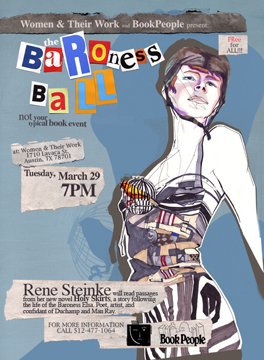
The Baroness Ball: Holy Skirts Book Signing
Women & Their Work and BookPeople proudly presented The Baroness Ball, an event that celebrated the release of René Steinke’s novel, Holy Skirts. Holy Skirts followed the life of the Baroness Elsa, the foremother of the Dada movement, in her quest to make her life a piece of artwork. The event was a masterpiece itself. Steinke read passages from her novel while Austinites showed off how Dada we all are. Women & Their Work and BookPeople encouraged everyone to dress in their best found object ensemble.
About Holy Skirts
In 1917 no one had ever seen a woman like the Baroness Elsa von Freytag-Loringhoven. She regally stalked the streets of Greenwich Village wearing a bustle with a flashing taillight, a brassiere made from tomato cans, or a birdcage necklace; declaimed her poems to sailors in beer halls; and enthusiastically modeled in the nude for artists such as Man Ray and Marcel Duchamp, setting the city ablaze with her antics. Before today’s outsized celebrities, there was the Baroness — poet and artist, proto-punk rocker, sexual libertine, fashion avatar, and troublemaker. At the center of the Dadaist circle, the Baroness transformed herself into a living, breathing work of art.
Holy Skirts is a vivid imagining of the Baroness’s story. Beginning in 1904, with Elsa’s burlesque performance onstage in Berlin’s Wintergarten cabaret, the adventures continue across Europe, through turbulent marriages and love affairs, until the Baroness finally lands in New York City, just before America enters the war. As she befriends Greenwich Village artists and writers, she defines herself as a poet, even as she breaks the bonds of female propriety.
In a beautifully written novel, René Steinke paints an exquisite portrait of this woman and her time — an era of cataclysmic change that witnessed brutal war, technological innovation, the rise of urban living, and an irrevocable shift in the lives of women, who, like Elsa, struggled to create their own destinies. Holy Skirts is a celebration of resilience and imagination, an exploration of the world in which the modern woman was born, and a testament to the lost bohemia.